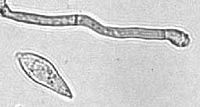
Photo from wikipedia
Rice blast (Pyricularia oryzae) has become a serious disease on commercial rice (Oryza sativa) crops in northern Australia and is present there on wild rice (O. australiensis). Characterisation of the… Click to show full abstract
Rice blast (Pyricularia oryzae) has become a serious disease on commercial rice (Oryza sativa) crops in northern Australia and is present there on wild rice (O. australiensis). Characterisation of the host range of P. oryzae is fundamental to both reducing disease spread and to preventing development of epidemics via better management of Poaceae inoculum reservoirs in Australia. Studies on response of three different wild O. australiensis sources toward four isolates of P. oryzae showed all genotypes very susceptible to three isolates [WAC13466 (race IA-1), BRIP53376 (race IB-3), NT2014a (race unknown)], but resistant to isolate BRIP39772 (race IA-3). Studies to investigate levels of blast disease development following inoculation on a range of Poaceae hosts showed both P. oryzae isolates (WAC13466, BRIP53376) were highly virulent on barley (disease index, DI = 100%), and on Phalaris and O. australiensis (DI = 70%). However, isolate BRIP53376 showed a significantly higher level of aggressiveness (DI ~80%) on ryegrass, wild oat and rice. Of the two wheat cultivars tested, only one cultivar showed disease and only from WAC13466 (DI ~30%). Sweet corn and goosegrass were also susceptible to both blast isolates, but DI was <50%. That P. oryzae was virulent across these diverse Poaceae hosts, highlights, for Australia, the possibility for these species in, first, harbouring P. oryzae isolates highly virulent to commercial rice, second, fostering spread of rice-attacking P. oryzae strains into regions currently free of rice blast, and third, potential for these alternative host species to encourage development of more virulent host-specific strains of P. oryzae. The current study is an important step towards facilitating improved crop protection in the medium and long term from reducing P. oryzae disease epidemics via a better understanding and management of inoculum reservoirs in Australia.
Journal Title: European Journal of Plant Pathology
Year Published: 2021
Link to full text (if available)
Share on Social Media: Sign Up to like & get
recommendations!